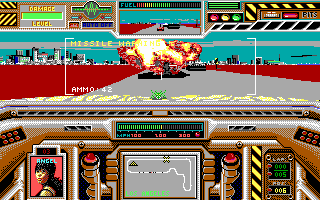Retro Replay Review
Gameplay
Deathtrack drops you into a ruthless future motorsport where victory means cold hard cash—and survival. From the outset you’re handed a modest bankroll and must decide whether to invest in speed, firepower or armor by selecting one of three starter vehicles. Each chassis presents a distinct playstyle: the lightweight racer darts through opponents, the firepower-oriented car relies on its arsenal to carve a path, and the heavily armored juggernaut absorbs enemy attacks while plowing ahead. This initial choice dramatically influences how you approach each of the ten available tracks.
Races aren’t just about crossing the finish line first; they’re gladiatorial contests where opponents actively seek to eliminate you. Armed with missiles, machine guns and other futuristic weaponry, rival drivers will relentlessly target your vehicle’s weak points. You’ll need to master evasive maneuvers, strafing attacks and judicious use of boost to stay alive. A well-timed nitro burst can help you slip past a blockade or escape an ambush, but reckless boosts can leave you exposed.
The progression loop centers on earning prize money and investing it back into your car. Armor plating, weapon upgrades and performance parts each carry their own strategic weight: beefing up your defenses makes you tougher at the cost of speed, while high-end weapons let you dispatch rivals more quickly but drain your wallet. Balancing these upgrades becomes critical as you climb through increasingly lethal circuits. Practice modes allow you to refine your skills, but the heart-pounding thrill comes from wagering everything in the high-stakes Deathtrack events.
Graphics
For its era, Deathtrack’s visuals stand out with crisp 3D polygonal models for the cars and track environments. The polygon counts are modest by modern standards, yet the designers make clever use of color and angular silhouettes to convey speed and aggression. Textured surfaces are simple, but environmental cues—like dust trails, skid marks and debris—add urgency to each race.
One of the game’s most memorable touches is the use of 16-colour digitized photographs for your opponents. These low-resolution portraits appear during pre-race introductions, lending a gritty, analog charm to the character roster. While not high-def by any stretch, the photo splendor gives personality to each rival and reinforces the narrative that these are real drivers risking everything.
Track design spans ten unique locales across a future America: from sun-baked desert highways to neon-lit urban sprawls and derelict industrial zones. Each environment is distinct, featuring hazards such as oil slicks, crashing obstacles and tight chicanes. Frame rates are smooth enough to maintain a sense of velocity, though occasional popping of distant geometry reminds you this is a product of its time. Ultimately, the graphics convey a satisfying blend of speed, danger and retro flair.
Story
Deathtrack’s narrative framework is lean but effective: in a dystopian future, high-risk races across America settle debts, feuds and fortunes. You assume the role of “the rookie,” an up-and-coming driver with nothing to lose. This underdog premise injects purpose into each race—you’re not just chasing cash but fighting to carve out your place in the unforgiving Deathtrack circuit.
Rather than lengthy cutscenes, story elements arrive through brief voiceovers, taunting headlines and those iconic 16-colour photos of your rivals. You learn snippets about each adversary’s backstory—some are military veterans, others outlaw speed freaks—but most details are left to your imagination. This minimalism keeps the focus on gameplay, while still offering enough context to make each victory personal.
Although there’s no branching narrative or dramatic plot twists, the escalating stakes and occasional dramatic loss of a beloved car part create an emergent story of survival. Every race win and upgrade fuels your journey from penniless rookie to feared champion. The writing is lean, functional and designed to keep you glued to the driver’s seat rather than the dialogue box.
Overall Experience
Deathtrack delivers a high-octane blend of racing and vehicular combat that remains engaging decades after its release. The core loop of earning money, upgrading your ride and tackling increasingly ferocious opponents never grows stale. Each of the ten tracks poses fresh tactical challenges, and the balance between offense and defense keeps gameplay dynamic.
While some modern gamers may find the graphics rudimentary and the interface dated, the charm of polygonal speed and digitized rival portraits holds a nostalgic appeal. The audio design—engine roars, weapon blasts and crowd cheers—further sell the immersive death-race atmosphere. Challenge-seekers will appreciate the steep learning curve and the ruthless AI behavior that demands both skillful driving and strategic planning.
Ultimately, Deathtrack stands as a landmark title for fans of vehicular combat and retro racing experiences. Its straightforward narrative, addictive upgrade system and pulse-pounding action make it a compelling pick for those seeking danger-fueled thrills on four wheels. Whether you’re a newcomer curious about early ’90s design or a veteran racer craving a blast from the past, Deathtrack offers an unforgettable ride.
 Retro Replay Retro Replay gaming reviews, news, emulation, geek stuff and more!
Retro Replay Retro Replay gaming reviews, news, emulation, geek stuff and more!









Reviews
There are no reviews yet.